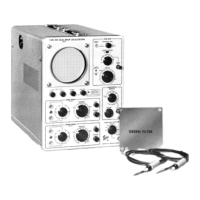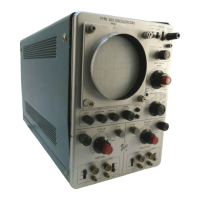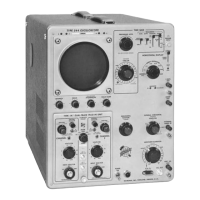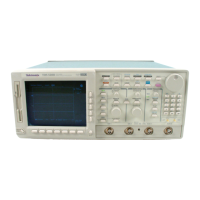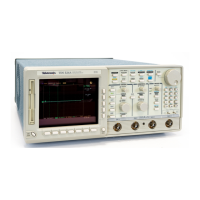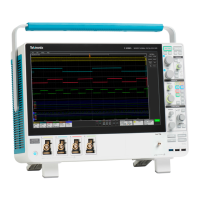Circuit
Description—
5103N
four portion
of
the
Countdown Circuit (U640C-U640D) are
used
for
plug-in
switching; one output is sent to contact
A15
of
J604
to produce
plug-in switching on the single-
beam-display
auxiliary board, and the other output is sent
via contact
B21
of
J603
to
produce dual-sweep
switching in
dual time-base
units. The
vertical
mode
switching
sequence
and some of the
display combination possibilities are
fully
discussed under
General Operating
Information
in the
Operating I nstructions
section of
this manual.
Auxiliary Boards
Because
switching
between plug-ins
is
required for
simul-
taneous
viewing of
displays
on
single-beam
cathode-ray
tubes and not
required
for
use with dual-beam cathode-ray
tubes, an
auxiliary board is
supplied
with each display unit
to
provide the correct
signal-routing function.
An auxiliary
board plugs into
J604
on the Interface circuit board,
and
becomes part
of the Interface circuit. The single-beam
auxiliary
board
accepts
the push-pull signal outputs from
both
vertical plug-ins. Emitter
followers
Q701,
Q703,
Q711,
and
Q713
provide
a
high-impedance
input to two
pairs of grounded-gate FET amplifiers,
Q702-Q704
and
Q712-Q714.
The
switching circuit consists of Q721
and
Q722,
connected as a
comparator. Plug-in
“on'' logic levels
are applied
to
the switching circuit in addition to the
switching signal
from the Countdown Circuit. The
switching circuit permits
only one pair of amplifiers
to be
on
at a
time, thus
permitting only one of the two vertical
plug-in signals to pass
to the Vertical Amplifier. In the
chopped switching mode, the
switching between pairs of
amplifiers occurs at a
50-kilohertz rate (switching occurs on
both the negative-
and positive-going transition), and in
the
alternate mode, switching
occurs at the end
of
every second
sweep.
If
no “on"
logic level is applied to the switching
circuit
from either vertical plug-in, Q702 and Q704 will
remain on, passing
any signal
from
the left vertical plug-in.
The
dual-beam
auxiliary
board has
no switching circuit.
It routes
the signal
from the left vertical
plug-in to the
Vertical
Amplifier circuit on the Interface circuit board,
and amplifies the
signal from the right vertical plug-in.
The
amplifier circuit on
the dual-beam auxiliary board is identi-
cal
to
the Vertical
Amplifier
which
is discussed next, and
consists
of
Q701,
Q702, Q711,
and Q712. The output of
this amplifier is sent
directly to the lower-beam deflection
amplifier in the display
unit.
Vertical
Amplifier
The Vertical
Amplifier circuit provides
approximately
10X
amplification of the vertical signal before passing it
to
the vertical deflection
amplifier in the display
unit. The
Vertical
Amplifier consists of
Q650, Q658, Q660, Q668,
and their associated
passive components, connected in
a
differential configuration.
The output signal is in
phase
with the output
of the vertical plug-in.
Horizontal
Amplifier
The
Horizontal
Amplifier
consists of
Q670, Q678,
Q680,
Q688,
and
their
associated
passive
components.
The
circuit
is nearly
identical
to the
Vertical
Amplifier
just
described.
It
receives
a push-pull
input
directly
from
the
horizontal
plug-in compartment
via contacts
A7, A13,
B7,
and
B13
of
J603.
The two
halves of
this amplifier
are
balanced
in the
quiescent condition
by adjustment
of
R675,
Horiz
Cent.
The output of
the
Horizontal
Amplifier
is sent
to the
horizontal
deflection
amplifier
in the
display
unit.
POWER SUPPLY
General
The
Power
Supply
circuit
provides
the
low-voltage
operating
power for
the oscilloscope
system from
three
regulated
supplies and
three
unregulated
supplies.
Elec-
tronic
regulation
is used
to provide
stable,
low-ripple
out-
put
voltages.
The circuit also
includes
the calibrator
circuit
to
produce an
accurate
square-wave
output.
Power
Input
Power
is applied
to the primary
of transformer
T801
through
the
display
unit (fuse
F201, thermal
cutout
S200,
and Power
switch
S201),
and the line-selector
block, P810.
The
line-selector
block allows changing
the
primary -winding
taps of
T801 to
fit
different
line requirements.
Low-Voltage
Rectifiers
and
Unregulated Outputs
The
full-wave bridge
rectifiers
and associated filter
com-
ponents in
the secondaries of
T801 provide filtered
DC
voltages for
operation of the
oscilloscope
system or for
regulation
by the
Low-Voltage
Regulators.
The
unregulated
outputs
are +200 volts, +38
volts,
and
—38
volts.
The
+205-volt and
+38-volt
outputs to the
display unit are fuse-
protected
by F810 and F835
respectively.
Low-Voltage
Regulators
-30-Volt
Supply.
The
-30-Volt
Supply,
besides
pro-
viding
power
to
circuitry
throughout
the
instrument,
provides
a
reference-voltage
source
to
establish
operating
levels
for the
feedback
regulators
in the
+30-Volt
and
+5-Volt
supplies.
The regulator
for
the
-30-Volt
Supply is
a
feedback
amplifier
system which
operates
between
ground
and the
unregulated
-38
volts.
Current
to the load
is delivered
by the
series-pass
transistor,
Q860,
and the
supply
voltage
is
established
by the
drop
across
R877,
R878,
and
R879.
The
feedback
path
is through
R875,
Q875,
and
Q865 to the
base of
Q860.
Any variation
in
output
voltage
due
to ripple,
change
of
current
through
the
load,
etc., is
immediately
transmitted
to
the base
of
Q860
and
nullified
by
a change
in
Q860 conduction,
thus
main-
3-2

